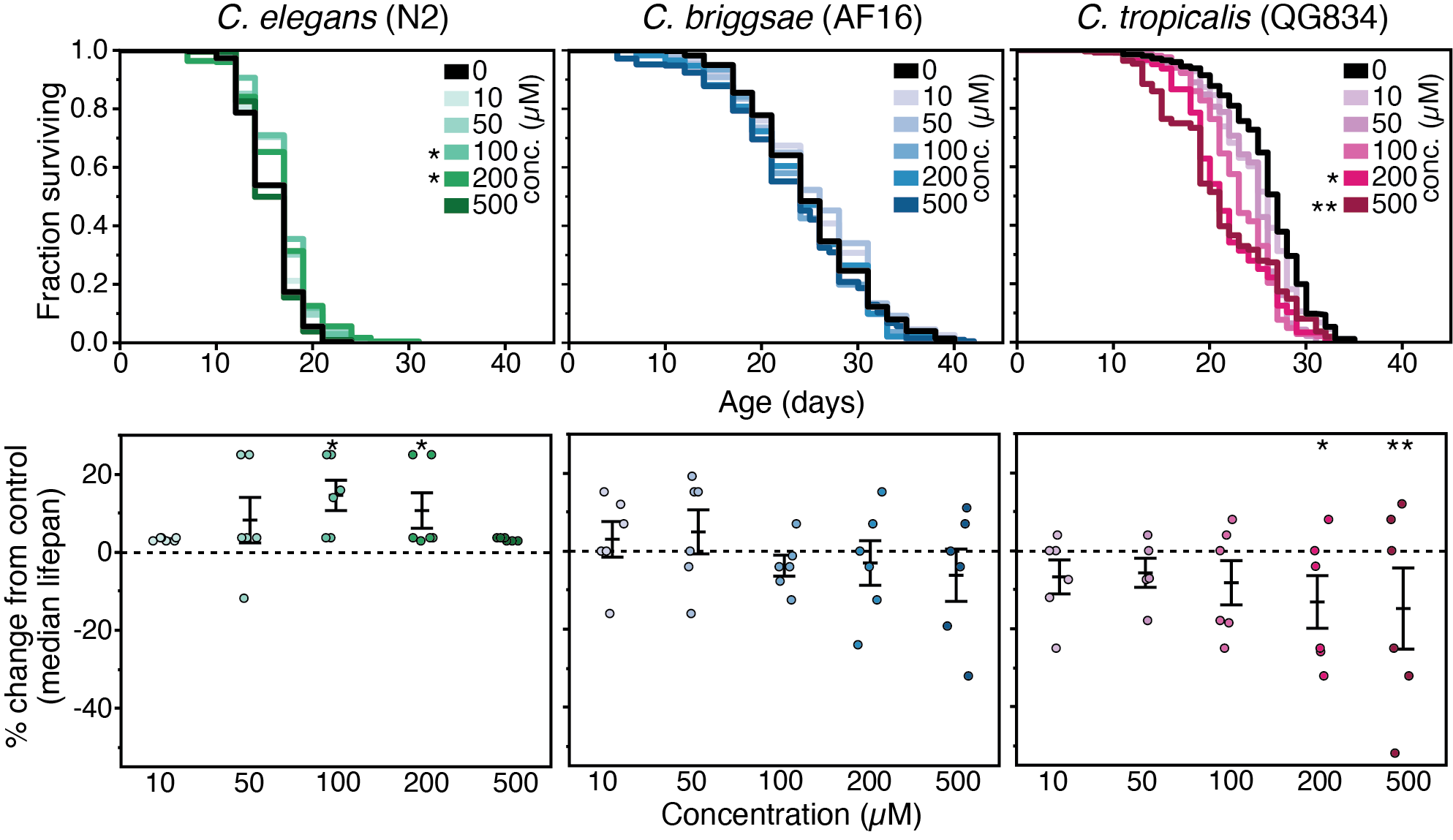Institute of Ecology and Evolution, University of Oregon, Eugene, Oregon 97403, USA
Division of Aging Biology, National Institute on Aging, Bethesda, Maryland 20892, USA
Department of Molecular Biology and Biochemistry, Rutgers University, Piscataway, New Jersey 08854, USA
Description
The Caenorhabditis Intervention Testing Program (CITP) is a multi-institutional, National Institute on Aging (NIA)-funded consortium with the goal of identifying compounds that will robustly extend lifespan with reproducible effects across genetically diverse Caenorhabditis species and strains (Lucanic et al., 2017). Compounds are prioritized for testing based on computational prediction for lifespan or healthspan effects (Coleman-Hulbert et al., 2019), predicted or known interactions with documented lifespan-regulating pathways, or previous reports for lifespan or healthspan extension in laboratory animals. In this case, diuron was of interest to CITP based on the report of a positive effect on the lifespan of C. elegans strain TJ1060 (spe-9;fer-15) (Lucanic et al., 2018; personal communication). Diuron (1-(3,4-dichlorophenyl)-3,3-dimethylurea) is an herbicide that inhibits photosynthesis by binding photosystem II (Haynes et al., 2000). Diuron has been previously tested in nematode species for toxicity (Neury-Ormanni et al., 2019) and reproductive effects (Mugova et al., 2018), and in both cases showed detrimental effects at high doses only.
We assayed lifespan in response to diuron exposure at five different concentrations across three species of Caenorhabditis nematodes following our previously published protocols (Lucanic et al., 2017). Briefly, animals were age synchronized by performing a four-hour long egg lay on Nematode Growth Media (NGM) agar plates seeded with E. coli OP50-1. An average of 40 day one adult worms were transferred in triplicate to 30 mm NGM agar plates seeded with the E. coli strain OP50-1 and containing 50 µM 5-Fluoro-2′-deoxyuridine (FUdR). Diuron (Sigma Aldrich) was dissolved in DMSO at a concentration such that 7.5 µl of diuron solution and 125 µl of water were added to each 3 mL plate to obtain final concentrations of 10 µM, 50 µM, 100 µM, 200 µM, and 500 µM. Control plates were treated with 125 µl water and 7.5 µl DMSO. Nematodes were maintained at 20˚C and transferred to fresh plates on days 1, 2, and 4 (C. tropicalis) or 5 (C. briggsae and C. elegans) of adulthood, and once per week thereafter. Animals were scored manually for movement, and those that showed no movement, either spontaneous or after gentle perturbation with a 0.2 mm diameter platinum wire, were scored as dead. Animals that had burrowed or escaped the NGM plate were censored in the final analysis. The experiment was repeated in two biological replicates, with an average of 40 animals per condition across three technical replicates, for a total of 4,920 animals.
Our results indicate that diuron does not exert robust positive effects on lifespan across three species of Caenorhabditis nematodes (Fig. 1). C. elegans strain N2 showed a weakly significant, non-robust increase in mean lifespan at 100 µM and 200 µM. Conversely, C. tropicalis showed a significant, robust, and dose dependent decrease in lifespan at 200 µM and 500 µM, with high variability observed across biological replicates. C. Briggsae strain AF16 showed no significant increase or decrease in lifespan. Diuron was of interest to CITP due to effects on lifespan in a preliminary screen on C. elegans strain TJ1060 (Lucanic et al., 2018; personal communication), results that were not reproduced when tested under CITP test conditions and in CITP strains. Diuron has been shown to have toxic effects on some strains of nematodes in high concentrations (Neury‐Ormanni et al., 2019), consistent with our results in C. tropicalis (Fig. 1). Under CITP testing, the lifespan extension effect observed was small and restricted to the elegans species of Caenorhabditis. For similar initial trial lifespans in the CITP, a lifespan increase of 10% or higher is an indication that an intervention merits further testing. For example, NP-1 showed a consistent lifespan increase of ~30%, and therefore this compound was subject to extended testing by three CITP labs (Lucanic et al., 2017). Diuron did not exceed an increase of 8.7%, conferred variable effects, and thus did not merit further testing in the CITP platform.
Reagents
| Reference strain | Species | Available from |
| N2 | Caenorhabditis elegans | CGC |
| QG834 | Caenorhabditis tropicalis | CGC |
| AF16 | Caenorhabditis briggsae | CGC |
| OP50-1 | Escherichia coli |
Acknowledgments
We acknowledge all members of the Lithgow, Driscoll, and Phillips labs, Anna Coleman-Hulbert in particular. We thank the CITP advisory committee for extensive discussion. All strains were procured from the NIH Office of Research Infrastructure Programs-funded (P40 OD010440) Caenorhabditis Genetics Center (CGC).
References
Funding
This work was supported by National Institutes of Health grants U01 AG045864 to MD, UO1 AG045844 to GJL, and U01 AG045829 and U24 AG056052 to PCP.
Reviewed By
AnonymousHistory
Received: April 19, 2021Revision received: August 17, 2021
Accepted: August 26, 2021
Published: September 23, 2021
Copyright
© 2021 by the authors. This is an open-access article distributed under the terms of the Creative Commons Attribution 4.0 International (CC BY 4.0) License, which permits unrestricted use, distribution, and reproduction in any medium, provided the original author and source are credited.Citation
Osman, HC; Sedore, CA; Jackson, EG; Battistoni, ET; Hall, D; Foulger, A; Lucanic, M; Guo, M; Driscoll, M; Phillips, P; Lithgow, GJ (2021). Caenorhabditis Intervention Testing Program: the herbicide diuron does not robustly extend lifespan in nematodes. microPublication Biology. 10.17912/micropub.biology.000448.Download: RIS BibTeX




